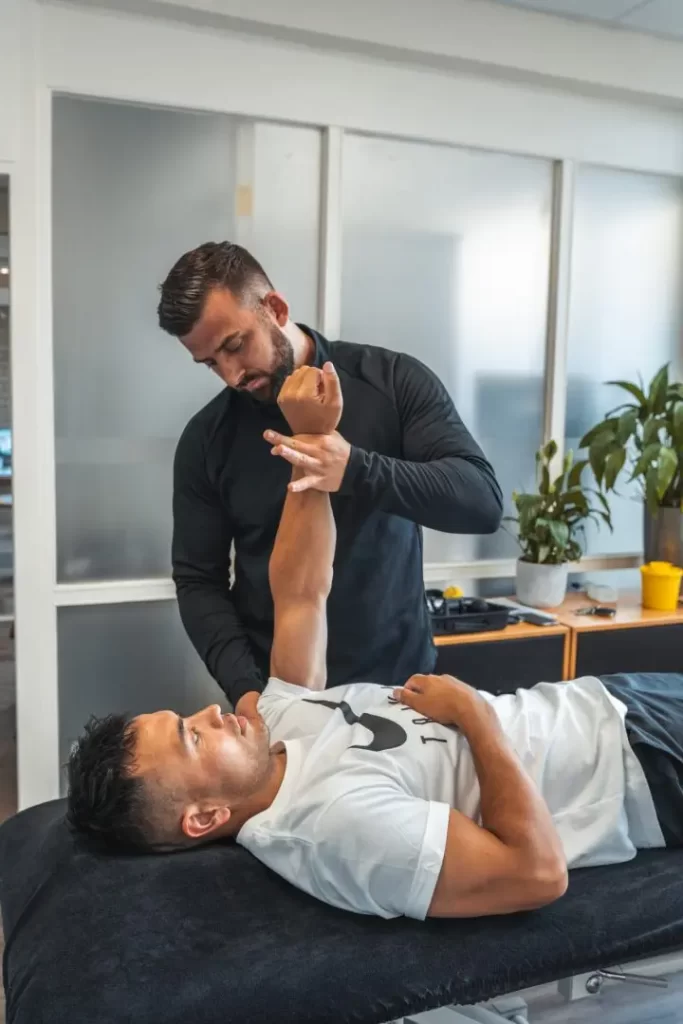Piriformis syndrome
Piriformis syndrome occurs in athletes in the hip-bill region (6:1, more often in women than men in the age range 30-40 years). The injury is manifested by a dull pain in the upper, deep part in the gluteal muscle. The piriformis muscle is shaped like a flat stretched pear shape and is located in the gluteus region (buttock region). Piriformis syndrome can lead to loss of strength and stiffness. Under the piriformis muscle runs the sciatic nerve, which runs from the low back to the leg. Pressure on the sciatic nerve can lead to various symptoms, often manifesting as a nagging sensation. These complaints can be felt in the back and buttock and in some cases radiate to the leg. Prolonged sitting can increase complaints, in some cases it is sometimes referred to as 'wallet syndrome', where sitting with a wallet in the back pocket gives constant pressure on the nerve. In this blog, we'll tell you more about piriformis syndrome and what you can do about it (with us)!
In piriformis syndrome, there is a nagging pain in the buttock region which is caused by the nervus ischiadicus (nerve in the buttock). The N. Ischiadicus arises from the lower back, through the buttock and runs down to the leg. Radiation symptoms can occur due to constant pressure on the nerve, in some cases there is then tingling this can sometimes also lead to a numb feeling.

Causes of piriformis syndrome
General have women an increased risk of piriformis syndrome in the age range 30-40 years. A shortened/shortened muscle may be present and is a risk factor in its development. In addition, increased muscle tension also a possible cause for the development of piriformis syndrome. Because there is a local irritatie is of the musculus piriformis, a protective mechanism of the body may be a palpable thickening (fluid or hydrops in Latin). Adhesions can occur as a result of too much tensile force, for example when too much force is applied too quickly in an early rehabilitation phase (after hip surgery - example) too much tensile strength of the tissue is demanded. For this reason, building up slowly after surgery/injury is essential within physiotherapy.
This may result in a high rigidity (reduced flexibility) of this tissue. Other risk factors/causes that may play a role in the development of piriformis syndrome are; wrong footwear (indirect wrong walking pattern), reduced muscle strength in the thigh/bill region (hip abductors) allowing a Trendelenburg gait pattern may occur, misalignment of the big toe (halux valgus) or, as described earlier, an overuse (overload) complaint.
Complaint pattern
Complaints can manifest themselves diversely. A stabbing pain in the buttock (feeling like sitting on your wallet), pain at the hip (overall) or radiating to the back of the thigh, bending/stretching which will lead to worsening of symptoms and possibly reduced strength on one side of the lower body. In piriformis syndrome, complaints are often unilateral (unilateral). Loss of strength is explainable, when people unconsciously move differently or less, which can cause muscle loss. For this reason, continuing to move is essential to counteract muscle deterioration (reduction).

Treatment interventions.
Patients are treated through exercise therapy combined with partial rest. In the first phase of recovery, reduction of symptoms (pain) is one of the most primary treatment goals through adapted exercise. Looking at a pain score, a score of 4/10 (NPRS) is acceptable during rehabilitation. An ultimate goal is no or minimal complaints NPRS 0/10-2/10.
Stretching the piriformis is one of the treatment interventions offered alongside exercise therapy, in order to increase muscle length (and decrease muscle stiffness) in this way.
Mobilising can be both active and passive and may in principle be applied every day. Mobilising can be subdivided into directing or end-stance mobilising, whereby in rehabilitation we start with directing (increasing degrees of movement) and ultimately want to train to a maximum position (greater degrees of movement and end-stance movements, similar to the non-affected side), where no more movement restrictions will be present.
Besides active/passive mobilisations, strength training conductive wise will be built up adapted to the pain score (Numberic Pain Rating Scale).
Making an appointment at FysioFitaal
We work from multiple locations in Tilburg, always close by for professional and accessible physiotherapy. Fill in the contact form and we will contact you soon. Together, we will work on your recovery!

